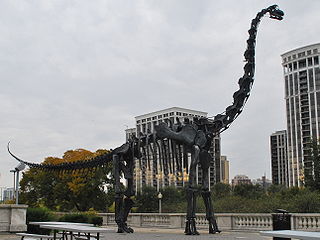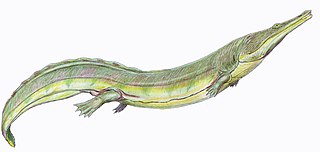
The Jurassic is a geologic period and stratigraphic system that spanned from the end of the Triassic Period 201.4 million years ago (Mya) to the beginning of the Cretaceous Period, approximately 145 Mya. The Jurassic constitutes the middle period of the Mesozoic Era and is named after the Jura Mountains, where limestone strata from the period were first identified.

The Brachiosauridae are a family or clade of herbivorous, quadrupedal sauropod dinosaurs. Brachiosaurids had long necks that enabled them to access the leaves of tall trees that other sauropods would have been unable to reach. In addition, they possessed thick spoon-shaped teeth which helped them to consume tough plants more efficiently than other sauropods. They have also been characterized by a few unique traits or synapomorphies; dorsal vertebrae with 'rod-like' transverse processes and an ischium with an abbreviated pubic peduncle.

Amygdalodon was a genus of basal sauropod from the Middle Jurassic of Argentina. The type species is Amygdalodon patagonicus. Fossils of Amygdalodon have been found in the Toarcian Cerro Carnerero Formation of the Jurassic. Very little is known about it, but it is one of the few Jurassic dinosaurs from South America found thus far.

Shunosaurus, meaning "shu lizard", is a genus of sauropod dinosaur from Late Jurassic (Oxfordian) beds in Sichuan Province in China, from 161 to 157 Million years ago. The name derives from "Shu", an ancient name for the Sichuan province.

Atlasaurus is a genus of sauropod dinosaurs from Middle Jurassic beds in North Africa.

Datousaurus was a dinosaur from the Middle Jurassic. It was a sauropod collected from the Lower Shaximiao Formation in Dashanpu, Zigong Sichuan province, China. It shared the local Middle Jurassic landscape with other sauropods such as Shunosaurus, Omeisaurus, Protognathosaurus, the ornithopod Xiaosaurus, the early stegosaur Huayangosaurus as well as the carnivorous Gasosaurus.

Lapparentosaurus is a genus of sauropod dinosaur from the Middle Jurassic. Its fossils were found in Madagascar. The type species is L. madagascariensis.

Trematosauroidea are an important group of Triassic temnospondyl amphibians. They flourished briefly during the Early Triassic, occurring worldwide before declining at the start of the Middle Triassic, although the group continued until the Late Triassic. They were medium-sized temnospondyls with wedge-shaped tails, narrow skulls, and, in advanced forms, elongated snouts. The latter feature was probably an adaptation for feeding on fish. The largest and most specialized family, the Trematosauridae, are the only batrachomorphs to have adapted to a marine lifestyle with the exception of the modern crab-eating frog.

Hypsocormus is an extinct genus of pachycormid fish from the Middle to Late Jurassic of Europe. Fossils have been found in Germany, France and the UK.

Turiasauria is an unranked clade of basal sauropod dinosaurs known from Middle Jurassic to Early Cretaceous deposits in Europe, North America, and Africa.

Ceratosauridae is an extinct family of theropod dinosaurs belonging to the infraorder Ceratosauria. The family's type genus, Ceratosaurus, was first found in Jurassic rocks from North America. Ceratosauridae is made up of the genera Ceratosaurus, found in North America, Tanzania, and Portugal, and Genyodectes, from the Early Cretaceous of Argentina. Unnamed probable ceratosaurids are known from limited material in the Middle Jurassic of Madagascar, the Late Jurassic of Switzerland, the Late Jurassic of Tanzania, and the Late Jurassic or possibly Early Cretaceous of Uruguay.

Rhizocorallium is an ichnogenus of burrow, the inclination of which is typically within 10° of the bedding planes of the sediment. These burrows can be very large, over a meter long in sediments that show good preservation, e.g. Jurassic rocks of the Yorkshire Coast, but the width is usually only up to 2 cm, restricted by the size of the organisms producing it. It is thought that they represent fodinichnia as the animal scoured the sediment for food.

Leptocleididae is a family of small-sized plesiosaurs that lived during the Early Cretaceous period. They had small bodies with small heads and short necks. Leptocleidus and Umoonasaurus had round bodies and triangle-shaped heads. Leptocleidids have been found in what were shallow nearshore, freshwater and brackish habitats. Hilary F. Ketchum and Roger B. J. Benson (2010), transferred Brancasaurus, Kaiwhekea, Nichollssaura and Thililua to this family. However, Ketchum and Benson (2011) reassigned Kaiwhekea and Thililua to their original positions, as an elasmosaurid and a polycotylid, respectively.
Phyllodontosuchus is a genus of sphenosuchian, a type of basal crocodylomorph, the clade that comprises the crocodilians and their closest kin. It is known from a skull and jaws from Lower Jurassic rocks of Yunnan, China. Phyllodontosuchus is unusual because some of its teeth were leaf-shaped, like those of some herbivorous dinosaurs, and it does not appear to have been a strict carnivore like most other crocodylomorphs.

Spinophorosaurus is a genus of sauropod dinosaur that lived in what is now Niger during the Middle Jurassic period. The first two specimens were excavated in the 2000s by German and Spanish teams under difficult conditions. The skeletons were brought to Europe and digitally replicated, making Spinophorosaurus the first sauropod to have its skeleton 3D printed, and were to be returned to Niger in the future. Together, the two specimens represented most of the skeleton of the genus, and one of the most completely known basal sauropods of its time and place. The first skeleton was made the holotype specimen of the new genus and species Spinophorosaurus nigerensis in 2009; the generic name refers to what was initially thought to be spiked osteoderms, and the specific name refers to where it was found. A juvenile sauropod from the same area was later assigned to the genus.

The Pediciidae or hairy-eyed craneflies are a family of flies closely related to true crane flies, with about 500 species worldwide.

Zuolong is an extinct genus of tetanuran theropod from the Late Jurassic period of China. The type and only species is Z. salleei. The generic name of Zuolong is in honor of General Zu Zōngtáng with the Chinese word "long" which means dragon. The specific epithet "salleei" is in honor of Hilmar Sallee, who funded the expedition which led to the specimen's discovery.

Piatnitzkysauridae is an extinct family of megalosauroid or basal allosauroid dinosaurs. It only consists of three to four known dinosaur genera: Condorraptor, Marshosaurus, Piatnitzkysaurus and possibly Xuanhanosaurus. The most complete and well known member of this family is Piatnitzkysaurus, which also gives the family its name.
Spiraloconulus is a genus of middle Jurassic forams with a coarsely agglutinated, microgranular, calcareous wall. The test is large, conical to cylindrical, coiled somewhat straight; the early coiled stage results in a flattened apex. Distinctly coiled microspheric tests are as much as 2 mm wide and 1.6 mm high. Megalospheric tests are smaller, up to 1.5 mm high and 1.1 mm wide.

Lingwulong is a genus of dicraeosaurid sauropod dinosaur from the Middle Jurassic of what is now Lingwu, Yinchuan, Ningxia, China. The type and only species is L. shenqi, known from several partial skeletons. It is the earliest-aged neosauropod ever discovered, as well as the only definite diplodocoid from east Asia.

















